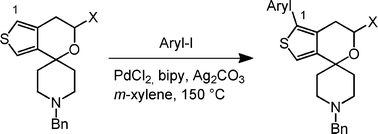The hypothesis that the σ1receptor will tolerate an additional aryl moiety in position 1 of the spirocyclic system was based on spirocyclic pyrazole derivatives, pharmacophore models of σ1receptor ligands and DFT calculations. The strategy of introducing the aryl residue at the final step of the synthesis allowed the preparation of a large set of diverse ligands for the exploitation of the hydrophobic pocket of the σ1receptor protein. The catalyst system PdCl2/2,2′-bipyridyl/Ag2CO3 is able to introduce various aryl groups onto the α-positions of spirocyclic thiophene derivatives 5 and 6 to afford the target aryl-appended spirocyclic thiophenes 3 and 4. Although the σ1 affinity of the 1-phenyl substituted spirocyclic thiophenes 3a and 4a is slightly reduced compared with the σ1 affinity of the non-arylated compounds 5 and 6, both compounds represent very potent σ1receptor ligands (3a: Ki = 4.5 nM; 4a: Ki = 1.0 nM). This result indicates that an aryl moiety in position 1 is well tolerated by the σ1receptor protein. The substitution pattern of the additional phenyl moiety has only weak effects on the σ1 affinity. Even ligands 3f and 4h with extended naphthyl residue show high σ1 affinity. However, decrease of σ1 affinity by extension of the π-system to a biphenylyl substituent (4j: Ki = 30 nM) indicates that the biphenylyl residue is too large for the primary hydrophobic binding pocket of the σ1receptor.
